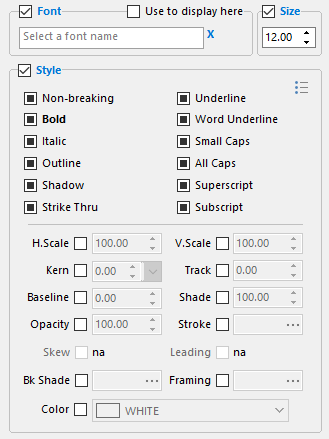The text attributes resulting actions determine if any particular text attribute should be applied to the text produced by a macro token.

Simple Attributes
These are determined by the state of a 3-way CheckBox.
When the CheckBox is checked it means apply the attribute, when it is unchecked it means remove the attribute, and when it is grayed out (as shown above) it means do not change the attribute one way or the other.
These are determined by a 2-way CheckBox and another control that gives a numeric value to the attribute.
If the checkbox is checked it means apply the attribute, if it is unchecked (as shown above) it means do not change the attribute one way or the other.
➢If you are using QuarkXPress 2017-2026, then you can specify the 3 new text attributes that were introduced with QuarkXPress 2017, namely: text background shading, text framing and text stroking.
➢If you are using InDesign, then you can specify text skewing.
Additionally, you can use the Font and Size settings to change the font of the text that will replace your token.
•The checkbox in the group header lets you disable any font action, which by default is disabled.
•Select the font to use from the font selector control.
•If you wish the text displayed in the text replacement settings to use the font you have selected, check the Use Above checkbox.

If your macro token is located inside an InDesign table, then you can specify that the selected format should be applied to all the cells of the table, or only to cells of the same row, or only to cells of the same column, or both, as shown on the right.

See also: text actions, paragraph actions, box actions, styles actions, and nResult actions.
Topic 108256, last updated on 02-Apr-2023